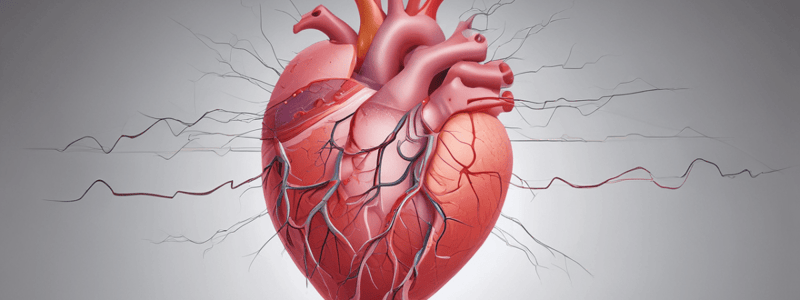Podcast
Questions and Answers
What is the characteristic QRS pattern in V1 that indicates a Right Bundle Branch Block (RBBB)?
What is the characteristic QRS pattern in V1 that indicates a Right Bundle Branch Block (RBBB)?
rSR pattern
What is the significance of a new onset of chest pain and a new RBBB in a patient?
What is the significance of a new onset of chest pain and a new RBBB in a patient?
Indicates critical occlusion of the Left Anterior Descending (LAD) artery
What is the difference between a complete RBBB and an incomplete RBBB?
What is the difference between a complete RBBB and an incomplete RBBB?
QRS duration is normal in incomplete RBBB
Which cardiac pathology can cause a Right Bundle Branch Block (RBBB)?
Which cardiac pathology can cause a Right Bundle Branch Block (RBBB)?
What is the role of the Bundle of His in the normal electrical pathway of the heart?
What is the role of the Bundle of His in the normal electrical pathway of the heart?
What is the term for the blockage of all three fascicules below the AV node, resulting in bi-fascicular block plus complete heart block?
What is the term for the blockage of all three fascicules below the AV node, resulting in bi-fascicular block plus complete heart block?
What type of block is associated with aortic stenosis, anterior MI, and congenital heart disease?
What type of block is associated with aortic stenosis, anterior MI, and congenital heart disease?
What is the term for the poor progression of the R-Wave in the ECG?
What is the term for the poor progression of the R-Wave in the ECG?
What is the term for the blockage of the left anterior fascicle and the right bundle branch?
What is the term for the blockage of the left anterior fascicle and the right bundle branch?
What is the term for the blockage of the left posterior fascicle and the right bundle branch?
What is the term for the blockage of the left posterior fascicle and the right bundle branch?
What is the term for the abnormal conduction of the electrical impulse through the ventricles?
What is the term for the abnormal conduction of the electrical impulse through the ventricles?
What are the three stages of ECG changes in Acute Coronary Syndrome?
What are the three stages of ECG changes in Acute Coronary Syndrome?
What is the ECG criterion for ST elevation in STEMI in limb leads?
What is the ECG criterion for ST elevation in STEMI in limb leads?
What is the difference between myocardial ischaemia, injury, and infarction?
What is the difference between myocardial ischaemia, injury, and infarction?
What is the characteristic of ST elevation in myocardial injury?
What is the characteristic of ST elevation in myocardial injury?
What is the term that describes the spectrum of conditions including unstable angina, NSTEMI, and STEMI?
What is the term that describes the spectrum of conditions including unstable angina, NSTEMI, and STEMI?
What is the characteristic of T wave inversion in myocardial ischaemia?
What is the characteristic of T wave inversion in myocardial ischaemia?
What is the significance of new LBBB in the ECG criteria for STEMI?
What is the significance of new LBBB in the ECG criteria for STEMI?
What is the difference between ST depression and ST elevation?
What is the difference between ST depression and ST elevation?
Flashcards are hidden until you start studying
Study Notes
Acute Coronary Syndrome (ACS)
- A spectrum of conditions including:
- Unstable angina (UA)
- Non-ST elevation myocardial infarction (NSTEMI)
- ST elevation myocardial infarction (STEMI)
- All have similar presentations, generally from plaque rupture and platelet aggregations, microcirculation/spasm
- The only difference is the degree of obstruction
ECG Criteria for STEMI
- Clinical symptoms consistent with ACS with ECG features including:
- ST elevation of ≥ 1mm in 2 contiguous limb leads
- ST elevation of ≥ 2mm in 2 contiguous chest leads
- New LBBB
- Evolution of ECG changes
Ischaemia, Injury, & Infarction
- Myocardial ischaemia: imbalance between myocardial oxygen supply and demand
- Ischaemia can progress to:
- Injury: ST segment elevation, cells stop functioning properly, still reversible
- Infarction: abnormal Q wave, not reversible
Myocardial Ischaemia
- T wave inversion
- ST depression
- Transient and brief, reversible
Myocardial Injury
- Hyperacute T waves
- Followed by ST elevation
- 1 mm or more in limb leads, 2 mm or more in chest leads
- Two or more contiguous leads, within minutes, reversible
ST Elevation
- Look for:
- Elevation above the isoelectric line
- Shape (concave up normal, concave down/horizontal abnormal)
- ST depression more commonly associated with ischaemia
- ST elevation more commonly associated with injury/infarction (STEMI)
Bundle Branch Blocks
- Right Bundle Branch Block (RBBB):
- Wide QRS due to delay in conduction
- Look at V1 and V6
- If QRS V1 is predominantly positive with an rSR pattern, you have a RBBB
- V6 often has a W pattern
- Causes of RBBB:
- Right ventricular hypertrophy
- Pulmonary embolism
- Ischemic heart disease
- Rheumatic heart disease
- Congenital heart defects
- Myocarditis
- Cardiomyopathy
- Incomplete RBBB:
- If rSR pattern is present in V1 but QRS is normal, you have an incomplete RBBB
Bi-Fascicular and Tri-Fascicular Block
- Bi-Fascicular Block: RBBB + LAFB or RBBB + LPFB
- Tri-Fascicular Block: involves all three fascicules below the AV node, resulting in bi-fascicular block PLUS complete heart block
Studying That Suits You
Use AI to generate personalized quizzes and flashcards to suit your learning preferences.




